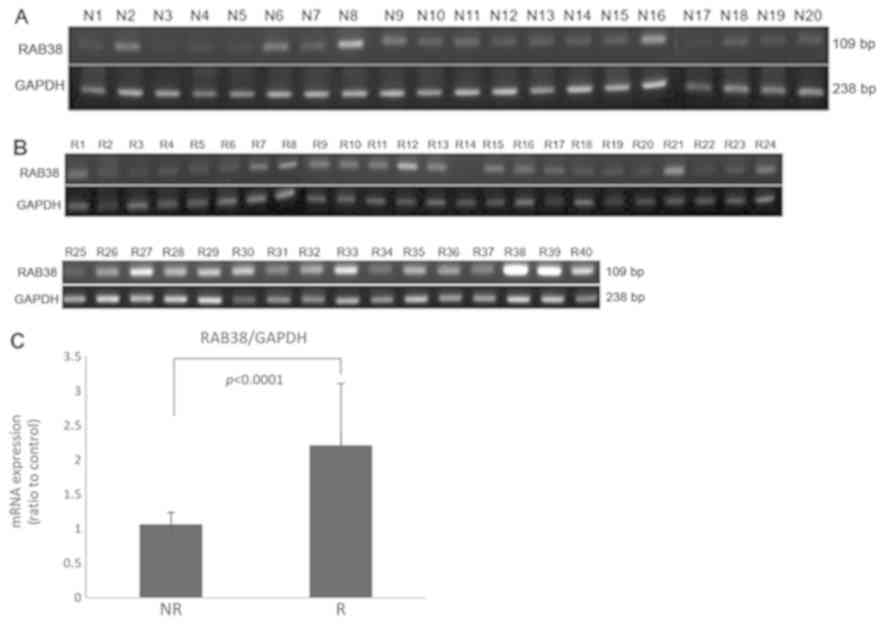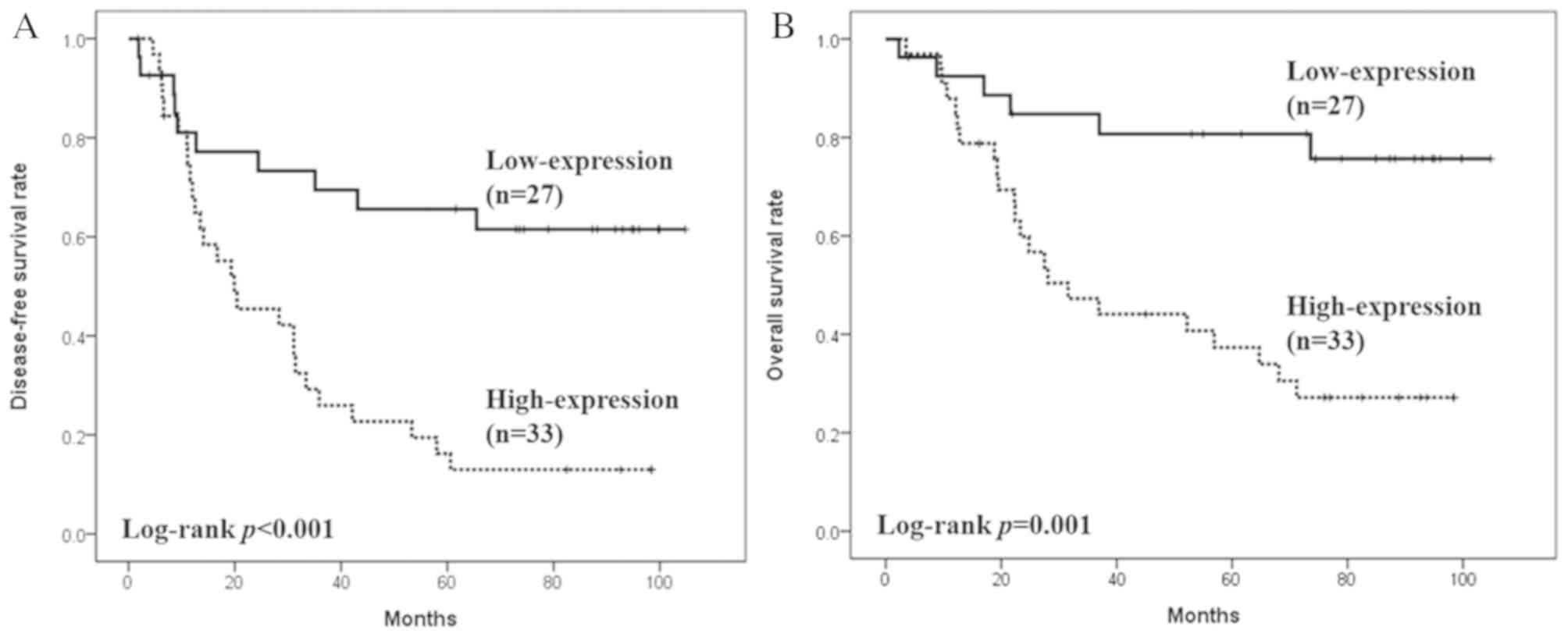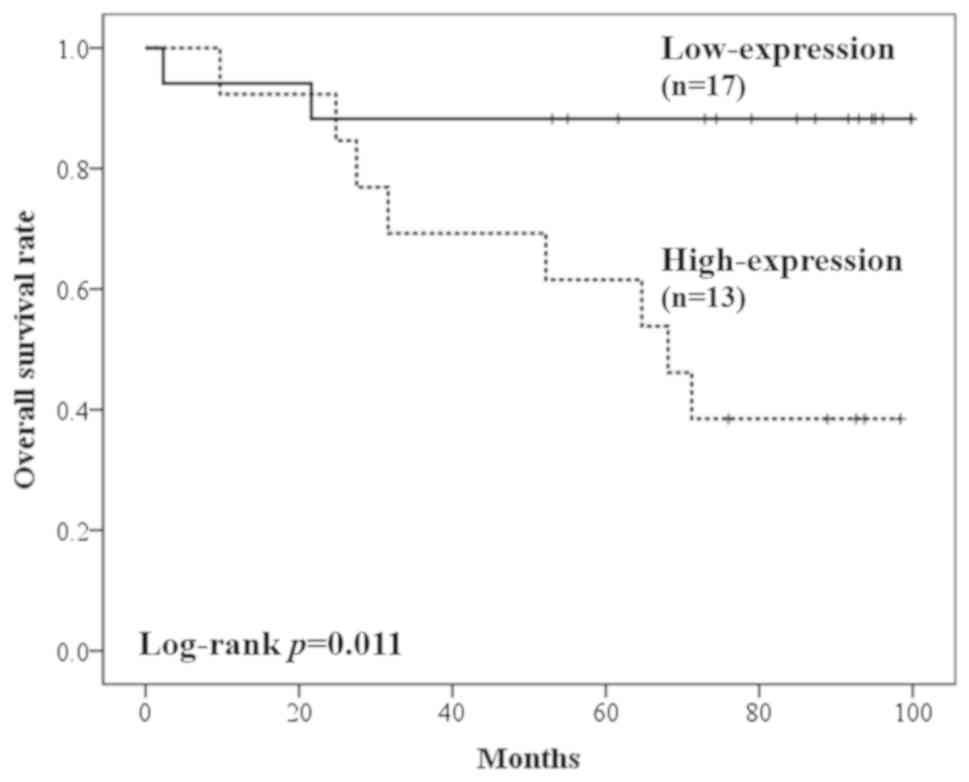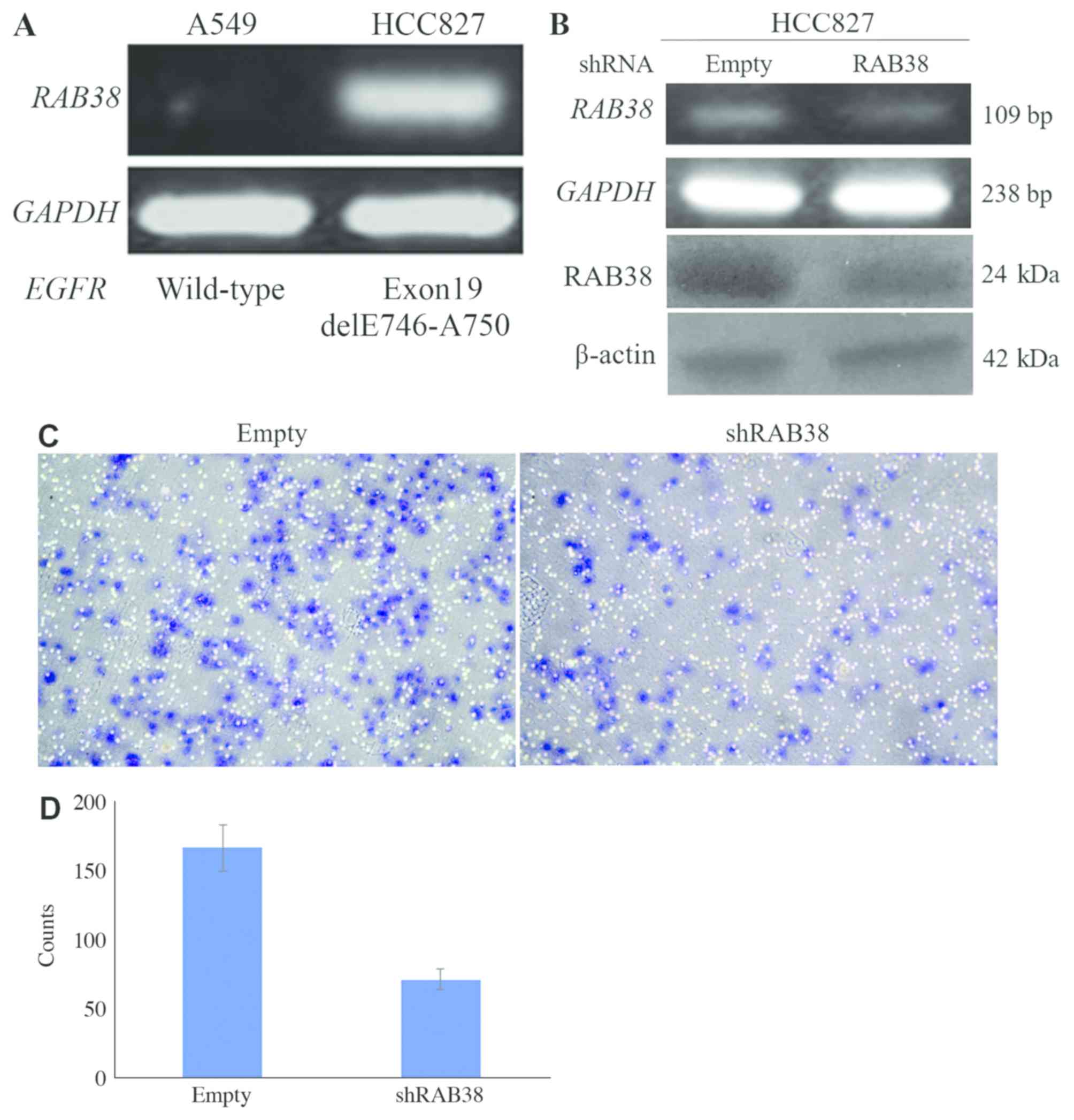RAB38 is a potential prognostic factor for tumor recurrence in non‑small cell lung cancer
- Authors:
- Published online on: June 28, 2019 https://doi.org/10.3892/ol.2019.10547
- Pages: 2598-2604
Abstract
Introduction
Lung cancer is the leading cause of cancer-associated mortality worldwide. Non-small cell lung cancer (NSCLC) accounts for >80% of all cases of lung cancer, and the majority of patients present with advanced disease at diagnosis (1). Despite recent advances in multi-modal therapy, the overall 5-year survival rate for NSCLC remains poor, ranging between 8 and 12%. Surgery continues to be the primary treatment option for localized NSCLC. However, the results of surgical treatment remain unsatisfactory, with 35–50% of patients experiencing disease relapse within 5 years.
RAB proteins are members of the Ras superfamily of GTPases that regulate intracellular trafficking (2). It has been revealed that a point mutation in the GTP-binding domain of RAB38 is responsible for human Hermansky-Pudlak syndrome, which is characterized by oculocutaneous albinism, bleeding diathesis and pulmonary fibrosis (3). Studies have investigated the potential role in regulating tumor progression (4); several RAB proteins have been identified in transcriptomic studies, exhibiting deregulated expression in malignant cells compared with normal tissues (5,6). However, the exact functions of these proteins in tumor biology remain to be fully elucidated. Accumulating evidence has demonstrated that RABs are overexpressed or upregulated in several types of cancer, including hepatoma, tongue, breast, pancreatic and prostate cancer (7–12); by contrast, the downregulation of certain RAB genes as a result of hypermethylation has been identified in colon, gastric and endometrial cancer (13,14).
RAB38 is a recently identified member of the RAB family of proteins and its expression is tissue-specific. RAB38 is predominantly expressed in melanocytes and melanoma tissues, but not in other normal tissues, serving as a melanocyte differentiation antigen (15). In gliomas, the expression levels of RAB38 have been associated with disease progression (16). However, the biological effects of RAB38 in other types of cancer remain unclear.
Utilizing two microarray platforms, a four-gene signature, including LCN2, PTHLH, RAB38 and FJX1, was identified as being significantly associated with tumor recurrence in patients with NSCLC (17). In the present study, the association between the expression of RAB38 and survival rate was further evaluated in patients with NSCLC. The results demonstrated that the expression of RAB38 was negatively associated with patient survival rate, and that knockdown of the expression of RAB38 attenuated tumor invasion in vitro. These results suggest that RAB38 may be used as an important prognostic predictor in NSCLC.
Materials and methods
Sample acquisition
Tumor tissues were retrospectively acquired from the Tissue Bank of Chang Gung Memorial Hospital (Taoyuan, Taiwan) following the standard procedure, and written informed consent was obtained from all patients. The tissue sections were reviewed by a pathologist, and only those comprising >50% tumor area were used (confirmed by hematoxylin and eosin staining). A total of 60 patients were enrolled in the present study and frozen specimens were available from all patients. The present study was approved by the Institutional Review Board of Chang Gung Memorial Hospital.
RNA extraction and semi-quantitative reverse transcription-polymerase chain reaction (RT-PCR) analysis
The patients were divided into two groups: Group R comprised patients who had tumor recurrence within 4 years following surgery, and Group NR comprised patients who remained disease-free 4 years following initial surgery. A total of 40 Group R and 20 Group NR cases of NSCLC were included. Following mechanical tissue disruption, total tumor RNA was extracted using the RNeasy Mini kit (Qiagen GmbH, Hilden, Germany) according to the manufacturer's protocol. Subsequently, 2–5 µg of total RNA was converted to cDNA using the SuperScript® III kit (Invitrogen; Thermo Fisher Scientific, Inc., Waltham, MA, USA), according to the manufacturer's protocol. The RAB38 and control GAPDH genes were amplified by PCR. The primers were as follows: RAB38, forward 5′-AGGCTGCGCTTCCCTGGTCA-3′ and reverse 5′-CCACGCCCAGGTCGCCAATC-3′; GAPDH, forward 5′-GACAACAGCCTCAAGATCATCA-3′ and reverse 5′-GGTCCACCACTGACACGTTG-3′. PCR amplification was performed in a total volume of 20 µl, containing 2–5 µg of cDNA. Following denaturation at 94°C for 5 min, a total of 30 thermal cycles were performed at 94°C for 30 sec, 55°C for 30 sec and 72°C for 30 sec. The amplified samples were mixed with gel loading dye and subjected to electrophoresis using a 1% agarose gel, containing 0.5 µg/ml ethidium bromide in 1X tris-borate-EDTA buffer. The gel was visualized and analyzed using ChemiCapt 3000 software (version 5.03; Vilber Lourmat, Marne-la-Vallée, France), and the expression levels of the PCR products were quantified using Image J v4.0 software (National Institutes of Health). The relative semi-quantitative RT-PCR density of RAB38 to GAPDH was quantified. High expression was defined as a ratio of RAB38 to GAPDH ≥0.5.
Cell culture and stable knockdown
The following human lung cancer cell lines were purchased from the American Type Culture Collection: HCC827, which expresses high levels of RAB38 and mutated epidermal growth factor receptor (EGFR: deletion, E746-A750) RNA, and A549, which expresses low levels of RAB38 and non-mutated EGFR RNA. The cells were maintained in RPMI 1640 (complete medium; Invitrogen; Thermo Fisher Scientific, Inc.). The Lentiviral Expression Vector system (dual function of TOOLSilent shRNA vector; Biotools Co., Ltd., New Taipei City, Taiwan) was used to establish stable RAB38-knockdown sublines with Lipofectamine® 3000 transfection reagent (Invitrogen; Thermo Fisher Scientific, Inc.) (target sequence, 5′-AATTCAAAAAAGCAATGAGTGTGACCTACTCTTGAACATTAGGTCACACTCATTTGCG-3′). The stable transfectants were selected using G418 for 2 weeks. The basal expression of RAB38 and knockdown efficiency were determined by RT-PCR, as described above.
Western blot analysis
The expression levels of the RAB38 were also detected by western blot analysis. The protein was extracted using ice-cold lysis buffer (20 mM Tris-base pH8.0, 150 mM NaCl, 1% NP-40) supplemented with a cocktail of protease inhibitor (cat. no. ab65621; Abcam) and the concentration of protein was determined using a Bradford protein assay. Subsequently, the protein (35 µg) was separated by a 4–15% gradient SDS-PAGE and transferred onto a nitrocellulose membrane. The blotted membrane was washed with tris buffered saline (TBS) for 5 min at room temperature and incubated in blocking buffer (1X TBS containing 5% non-fat milk) for 1 h at room temperature. The membrane was then incubated overnight at 4°C with a monoclonal antibody direct against human β-actin (1:10,000 dilution, cat. no. ab8224; Abcam, Cambridge, MA, USA) and RAB38 (1:100 dilution, cat. no. GTX51060; GeneTex, Inc., Irvine, CA, USA). Following washing three times for 5 min with 1X TBS containing 0.1% Tween-20, the membrane was incubated with a horseradish peroxidase-conjugated secondary antibody (1:5,000 dilution; RAB38 cat. no. ab97051; β-actin cat. no. 97023; Abcam) for 2 h at room temperature. The antigen-antibody interaction was traced with a chemiluminescence detection system. The blot signals were detected using a digital image system. These data were quantified by densitometric analysis with Image J v4.0 software, and the relative expression level was normalized by the internal standard β-actin.
In vitro invasiveness
The transfected cells were seeded into the upper wells of a BioCoat Matrigel invasion chamber (Corning, Bedford, MA, USA) in serum-free medium containing 0.1% BSA (Corning). The lower wells were filled with complete medium. Following incubation for 48 h at 37°C, a cotton swab was applied to remove the non-invaded cells in the upper chamber; those that had migrated through the filter pores were fixed and stained with 0.5% (w/v) crystal violet (cat. no. C6158; Sigma-Aldrich; Merck KGaA, Darmstadt, Germany) in methanol. Images were captured using a light microscope (IX70, Olympus Corporation, Tokyo, Japan), and analyzed with PAX–IT image analysis software (Midwest Information Systems, Villa Park, IL, USA).
Statistical analysis
Semiquantitative results are presented as the mean ± standard deviation. Differences in the expression of RAB38 were analyzed using Student's t-test. Categorical data were analyzed by Pearson's χ2 method. Disease-free survival (DFS) was defined as the period of time following primary surgical treatment until recurrence of NSCLC. Overall survival (OS) was defined as the date of diagnosis until mortality, or the most recent follow-up. The DFS and OS were estimated using Kaplan-Meier survival analysis, and the log-rank test was used to assess the difference between these two groups. For validation of the value of prognosticator, univariate and multivariate Cox proportional hazards analyses were also performed. Statistical analyses were performed with IBM SPSS version 20.0 software (IBM Corp., Armonk, NY, USA). P<0.05 was considered to indicate a statistically significant difference.
Results
Patient characteristics
A total of 60 patient samples were assessed. The patients' characteristics are shown in Table I. The mean patient age was 69.5 years in Group R and 71.5 years in Group NR. The sex ratio (male/female) was 2.08 in Group R and 2.33 in Group NR. The percentages of adenocarcinoma, adenosquamous cell carcinoma and squamous cell carcinoma were 62.5, 5.0 and 32.5% in Group R and 50.0, 10.0 and 40.0% in Group NR, respectively. There was no difference between the R and NR groups, with the exception that there was a higher number of cases of cancer stage III in Group R. In Group R, the stage distribution of I, II and III was 40.0, 17.5 and 42.5%; whereas in Group NR the stage distribution of I, II and III was 70.0, 25.0 and 5.0%.
Expression of RAB38 is higher in Group R samples compared with those in Group NR
In the present study, the expression of levels of RAB38 in 40 Group R (Fig. 1A) and 20 Group NR (Fig. 1B) frozen tumor tissues were assessed using semi-quantitative RT-PCR analysis. The results revealed that the expression levels of RAB38 were significantly higher in Group R samples compared with those in Group NR samples (P<0.0001; Fig. 1C).
RAB38 may be a prognostic factor in NSCLC
The expression level of the RAB38 was significantly associated with DFS and OS in patients with NSCLC. As shown in Fig. 2A, the median DFS was not reached in the RAB38 low expression group, whereas in the RAB38 high expression group, the DFS was 19.9 months [95% confidence interval (CI)=4.2–35.6 months; P<0.001]. The median OS was not reached in the RAB38 low expression group, whereas the OS of the RAB38 high expression group was 31.6 months (95% CI=15.0–48.2 months; P=0.001; Fig. 2B).
Consistent with previous results (17), the expression level of RAB38 was correlated with tumor recurrence. While 29 of the 33 patients (87.8%) with high expression levels of RAB38 developed recurrence, it was apparent in only 11 of the 27 patients (40.7%) with low expression levels of RAB38 (P=0.001). In Group R, the mRNA expression level of RAB38 was associated with poor OS, although this was not statistically significant (median OS, 37.0 vs. 27.5 months; P=0.335). Although the higher number of stage III cases in Group R may lead to a higher recurrence rate and poor prognosis in patients with a high expression of RAB38, poor prognosis was also observed in stage I cases (Fig. 3) in tumors with high expression of RAB38 (median OS, not reached vs. 68.1 months, P=0.011). The results of the univariate and multivariate analyses are shown in Table II. The univariate analysis revealed that only cancer stage (P=0.004) and the expression level of RAB38 (P=0.002) were prognostic factors for NSCLC. Cox multivariate analysis indicated that the expression level of RAB38 (P=0.010) was a more robust prognostic factor than stage status (P=0.053).
Table II.Univariate and multivariate overall survival analyses of 60 (R=40, NR=20) patients with non-small cell lung cancer using the Cox proportional hazards model. |
Expression of RAB38 is associated with the invasiveness of lung cancer cells
The expression of RAB38 was further analyzed in two human NSCLC cell lines. RAB38 was expressed at a higher level in HCC827 cells harboring an active EGFR mutation, compared with that in A549 cells expressing wild-type EGFR (Fig. 4A). Additionally, RAB38 silencing in the HCC827 cells (with a reduction of 20–30% according to RT-PCR and western blot data, Fig. 4B) substantially inhibited Matrigel invasiveness (with a reduction of 60%, Fig. 4C and D), indicating that the expression of RAB38 may be positively associated with lung cancer metastasis.
Discussion
In the present study, the gene expression of RAB38 was evaluated in patients with NSCLC; it was demonstrated that high levels of RAB38 were more frequently detected in stage III NSCLC, and that this was significantly associated with tumor recurrence and poorer OS. However, the mRNA expression level of RAB38 was also associated with poor OS in patients with stage I NSCLC. The small sample size may have contributed to this observation, thus further investigation with a larger sample number is required to confirm these conclusions. To the best of our knowledge, this is the first report describing the prognostic role of RAB38 in human NSCLC.
Although RAB proteins have been reported to be overexpressed in numerous types of cancer, the functionality of these proteins in cancer progression remains to be clarified. The tissue-specific expression pattern of RAB38 has previously been demonstrated. Jäger et al (18) reported that high RT-PCR signals were detected in cultured melanocytes and adrenal gland tissues; whereas weak to moderate signals were observed in the testes, kidney, uterus, prostate and pancreas. RAB38 mRNA was expressed in 80–90% of melanoma cases, but showed minimal expression in non-melanocytic malignancies. Although not detectable in lung tissues, the expression of RAB38 was observed in one of four lung cancer cell lines assessed, suggesting that it may serve a role in lung tumorigenesis (18). This study further demonstrated that RAB38 is strongly immunogenic, leading to spontaneous antibody responses in a significant proportion of patients with melanoma, and indicated that it may serve as a potential therapeutic target (19).
Chen et al (20) established a paired human lung adenocarcinoma cell line from primary tumor site tissues and metastatic lymph nodes and analyzed the gene expression profiles by microarray. The expression of RAB38 was markedly increased in tumor cells derived from metastatic lymph nodes compared with those from the primary tumor site. The present study revealed that gene silencing markedly reduced tumor cell invasion in HCC827 cells. Collectively, these findings suggest that RAB38 may be involved in lung cancer metastasis.
By contrast, in searching for potential tumor suppressor genes in lung cancer, Wu et al (21) reported that RAB37 was frequently downregulated in tumor tissues, compared with that in normal non-cancerous tissues, by promoter methylation, and that the low expression of RAB37 was associated with tumor metastasis. In addition, the expression of RAB37 was shown to be inversely correlated with cell motility in lung cancer cell lines (22), indicating the differential functionality of RAB proteins in lung cancer metastasis.
Crosstalk between integrin and growth factor receptor pathways has been reported to serve a prominent role in tumor progression (23,24). β1-integrin is required for EGFR signaling, and the silencing of β1-integrin substantially impairs the EGF-induced activation of EGFR in lung cancer cells (25). Ectopic expression of RAB25 was demonstrated to increase the expression of β1-integrin and subsequent activation of EGFR in breast cancer cells in vitro, and to increase tumorigenesis and pulmonary metastasis in ovarian cancer cells in vivo (26). The present study demonstrated that RAB38 was upregulated in cases of NSCLC associated with an active EGFR mutation, compared with those associated with wild-type EGFR, suggesting that the expression of RAB38 may be associated with EGFR status. However, only two cell lines were analyzed, and further investigation is required to confirm this association. Furthermore, the collection of additional tumor specimens is required to determine this association in patient tissues. Investigation of the functional analysis of RAB38 in NSCLC, in vitro and in vivo, is currently in progress.
In conclusion, the present study demonstrated that RAB38 is an important prognostic factor and potential therapeutic target in NSCLC.
Acknowledgements
The authors would like to thank Professor Alex YC Chang (Johns Hopkins Singapore) for data evaluation and as a consultant for manuscript writing. The authors also wish to thank the Laboratory of Dr Cheng-Hsu Wang (Chang Gung Memorial Hospital, Keelung branch) for their technical support.
Funding
The present study was supported by grants to JC (grant nos. CMRPG380761 and CMRPG3B0081~3) and MH (grant no. CMRPG3F1261) from Chang Gung Memorial Hospital, Taiwan.
Availability of data and materials
The datasets used and/or analyzed during the present study are available from the corresponding author on reasonable request.
Authors' contributions
JH and HC performed data analyses and wrote the manuscript. YS and MH collected the dataset, and contributed to data analyses and manuscript revision. JC and TH conceived and designed the study. All authors read and approved the final manuscript.
Ethics approval and consent to participate
In the original creation of the datasets, the Institutional Review Board of Chang Gung Memorial Hospital approved the study and informed consent to participate was obtained from all patients.
Patient consent for publication
Not applicable.
Competing interests
The authors declare that they have no competing interests.
Glossary
Abbreviations
Abbreviations:
|
NSCLC |
non-small cell lung cancer |
|
DFS |
disease-free survival |
|
OS |
overall survival |
References
|
Silvestri GA and Rivera MP: Targeted therapy for the treatment of advanced non-small cell lung cancer: A review of the epidermal growth factor receptor antagonists. Chest. 128:3975–3984. 2005. View Article : Google Scholar : PubMed/NCBI | |
|
Recchi C and Seabra MC: Novel functions for Rab GTPases in multiple aspects of tumor progression. Biochem Soc Trans. 40:1398–1403. 2012. View Article : Google Scholar : PubMed/NCBI | |
|
Osanai K and Voelker DR: Analysis and expression of Rab38 in oculocutaneous lung disease. Methods Enzymol. 438:203–215. 2008. View Article : Google Scholar : PubMed/NCBI | |
|
MAQC Consortium, ; Shi L, Reid LH, Jones WD, Shippy R, Warrington JA, Baker SC, Collins PJ, de Longueville F, Kawasaki ES, et al: The MicroArray Quality Control (MAQC) project shows interplatform reproducibility of gene expression measurements. Nat Biotechnol. 24:1151–1161. 2006. View Article : Google Scholar : PubMed/NCBI | |
|
Ho JR, Chapeaublanc E, Kirkwood L, Nicolle R, Benhamou S, Lebret T, Allory Y, Southgate J, Radvanyi F and Goud B: Deregulation of Rab and Rab effector genes in bladder cancer. PLoS One. 7:e394692012. View Article : Google Scholar : PubMed/NCBI | |
|
Dong W, Cui J, Yang J, Li W, Wang S, Wang X, Li X, Lu Y and Xiao W: Decreased expression of Rab27A and Rab27B correlates with metastasis and poor prognosis in colorectal cancer. Discov Med. 20:357–367. 2015.PubMed/NCBI | |
|
He H, Dai F, Yu L, She X, Zhao Y, Jiang J, Chen X and Zhao S: Identification and characterization of nine novel human small GTPases showing variable expressions in liver cancer tissues. Gene Expr. 10:231–242. 2002. View Article : Google Scholar : PubMed/NCBI | |
|
Shimada K, Uzawa K, Kato M, Endo Y, Shiiba M, Bukawa H, Yokoe H, Seki N and Tanzawa H: Aberrant expression of RAB1A in human tongue cancer. Br J Cancer. 92:1915–1921. 2005. View Article : Google Scholar : PubMed/NCBI | |
|
Culine S, Honore N, Closson V, Droz JP, Extra JM, Marty M, Tavitian A and Olofsson B: A small GTP-binding protein is frequently overexpressed in peripheral blood mononuclear cells from patients with solid tumours. Eur J Cancer 30A. 670–674. 1994. View Article : Google Scholar | |
|
Amillet JM, Ferbus D, Real FX, Antony C, Muleris M, Gress TM and Goubin G: Characterization of human Rab20 overexpressed in exocrine pancreatic carcinoma. Hum Pathol. 37:256–263. 2006. View Article : Google Scholar : PubMed/NCBI | |
|
Kotzsch M, Sieuwerts AM, Grosser M, Meye A, Fuessel S, Meijer-van Gelder ME, Smid M, Schmitt M, Baretton G, Luther T, et al: Urokinase receptor splice variant uPAR-del4/5-associated gene expression in breast cancer: Identification of rab31 as an independent prognostic factor. Breast Cancer Res Treat. 111:229–240. 2008. View Article : Google Scholar : PubMed/NCBI | |
|
Tan PY, Chang CW, Chng KR, Wansa KD, Sung WK and Cheung E: Integration of regulatory networks by NKX3-1 promotes androgen-dependent prostate cancer survival. Mol Cell Biol. 32:399–414. 2012. View Article : Google Scholar : PubMed/NCBI | |
|
Mori Y, Yin J, Sato F, Sterian A, Simms LA, Selaru FM, Schulmann K, Xu Y, Olaru A, Wang S, et al: Identification of genes uniquely involved in frequent microsatellite instability colon carcinogenesis by expression profiling combined with epigenetic scanning. Cancer Res. 64:2434–2438. 2004. View Article : Google Scholar : PubMed/NCBI | |
|
Shibata D, Mori Y, Cai K, Zhang L, Yin J, Elahi A, Hamelin R, Wong YF, Lo WK, Chung TK, et al: RAB32 hypermethylation and microsatellite instability in gastric and endometrial adenocarcinomas. Int J Cancer. 119:801–806. 2006. View Article : Google Scholar : PubMed/NCBI | |
|
Zippelius A, Gati A, Bartnick T, Walton S, Odermatt B, Jaeger E, Dummer R, Urosevic M, Filonenko V, Osanai K, et al: Melanocyte differentiation antigen RAB38/NY-MEL-1 induces frequent antibody responses exclusively in melanoma patients. Cancer Immunol Immunother. 56:249–258. 2007. View Article : Google Scholar : PubMed/NCBI | |
|
Wang H and Jiang C: RAB38 confers a poor prognosis, associated with malignant progression and subtype preference in glioma. Oncol Rep. 30:2350–2356. 2013. View Article : Google Scholar : PubMed/NCBI | |
|
Chang JW, Wei NC, Su HJ, Huang JL, Chen TC, Wu YC, Yu CT, Hou MM, Hsieh CH, Hsieh JJ, et al: Comparison of genomic signatures of non-small cell lung cancer recurrence between two microarray platforms. Anticancer Res. 32:1259–1265. 2012.PubMed/NCBI | |
|
Jäger D, Stockert E, Jäger E, Güre AO, Scanlan MJ, Knuth A, Old LJ and Chen YT: Serological cloning of a melanocyte rab guanosine 5′-triphosphate-binding protein and a chromosome condensation protein from a melanoma complementary DNA library. Cancer Res. 60:3584–3591. 2000.PubMed/NCBI | |
|
Walton SM, Gerlinger M, de la Rosa O, Nuber N, Knights A, Gati A, Laumer M, Strauss L, Exner C, Schäfer N, et al: Spontaneous CD8 T cell responses against the melanocyte differentiation antigen RAB38/NY-MEL-1 in melanoma patients. J Immunol. 177:8212–8218. 2006. View Article : Google Scholar : PubMed/NCBI | |
|
Chen J, Wang M, Zu L, Li W, Wang W, Li Y and Liu H: Abstract 4966: Establishment and characterization of a paired human non-small cell lung cancer cell lines from primary cancer and metastasis lymph node. Cancer Res. 74:2014. | |
|
Wu CY, Tseng RC, Hsu HS, Wang YC and Hsu MT: Frequent down-regulation of hRAB37 in metastatic tumor by genetic and epigenetic mechanisms in lung cancer. Lung Cancer. 63:360–367. 2009. View Article : Google Scholar : PubMed/NCBI | |
|
Tzeng HT, Tsai CH, Yen YT, Cheng HC, Chen YC, Pu SW, Wang YS, Shan YS, Tseng YL, Su WC, et al: Dysregulation of Rab37-mediated cross-talk between cancer cells and endothelial cells via thrombospondin-1 promotes tumor neovasculature and metastasis. Clin Cancer Res. 23:2335–2345. 2017. View Article : Google Scholar : PubMed/NCBI | |
|
Subramani D and Alahari SK: Integrin-mediated function of Rab GTPases in cancer progression. Mol Cancer. 9:3122010. View Article : Google Scholar : PubMed/NCBI | |
|
Huck L, Pontier SM, Zho DM and Muller WJ: Beta1-integrin is dispensable for the induction of ErbB2 mammary tumors but plays a critical role in the metastatic phase of tumor progression. Proc Natl Acad Sci USA. 107:15559–15564. 2010. View Article : Google Scholar : PubMed/NCBI | |
|
Morello V, Cabodi S, Sigismund S, Camacho-Leal MP, Repetto D, Volante M, Papotti M, Turco E and Defilippi P: β1 integrin controls EGFR signaling and tumorigenic properties of lung cancer cells. Oncogene. 30:4087–4096. 2011. View Article : Google Scholar : PubMed/NCBI | |
|
Jeong BY, Cho KH, Jeong KJ, Park YY, Kim JM, Rha SY, Park CG, Mills GB, Cheong JH and Lee HY: Rab25 augments cancer cell invasiveness through aβ1 integrin/EGFR/VEGF-A/Snail signaling axis and expression of fascin. Exp Mol Med. 50:e4352018. View Article : Google Scholar : PubMed/NCBI |













